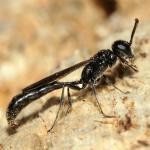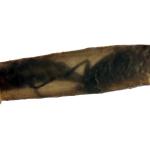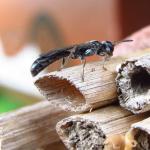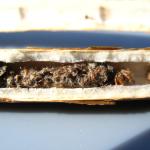A small, black, very thin solitary wasp. Identification keys are given in Yeo & Corbet (1995), Lomholdt (1984) and Richards (1980).
A widely distributed species recorded from much of Britain, including the Scilly Isles and the Channel Islands. There is a single record from Ireland.
Overseas, recorded from Europe, North Africa and much of Asia and has been introduced into North America (Antropov, 2002).
This species is not regarded as being scarce or threatened.
Has been recorded from a variety of habitats including woodland, parkland, gravel pits, sandy sites, chalk grassland and heathland.
On the wing between mid-May and mid-September.
Nest burrows are stocked with small spiders such as Tetragnatha (Tetragnathidae) (Lomholdt, 1984).
Nests are constructed in pre-existing cavities. Richards (1980) gives a generalised overview of Trypoxylon nesting sites such as “Anobium burrows, cut stems, hollow roots, rarely in small holes in vertical earth-faces”, but T. attenuatum seems to nest “exclusively in hollow plant stems” (Lomholdt, 1984). Nests are constructed in cavities 2-4 mm in diameter (Tormos et al., 2005).
No data available.
Parasites recorded include the chrysidid wasps Trichrysis cyanea (Linnaeus) and Pseudomalus auratus (Linnaeus) (Morgan, 1984). Lomholdt (1984) adds the non-British Pseudomalus [as Omalus] pusillus (Fabricius), together with the eurytomid wasp Eurytoma rubicola Giraud and the sarcophagid fly Amobia [as Pachyophthalmus] signata (Meigen).
2012





